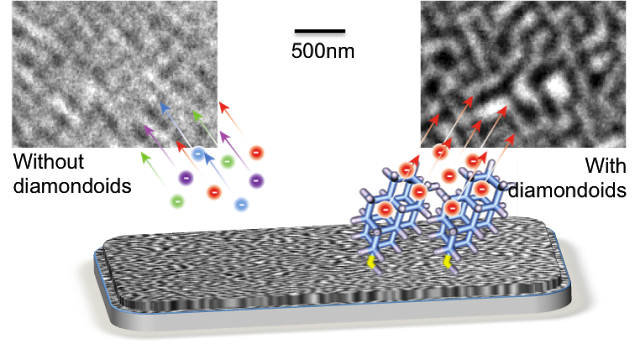

| Visitors Now: | |
| Total Visits: | |
| Total Stories: |

| Story Views | |
| Now: | |
| Last Hour: | |
| Last 24 Hours: | |
| Total: | |
Diamondoids Improve Electron Emitters
From
Diamondoids are nanoparticles made of only a handful of carbon atoms, arranged in the same way as in diamond, forming nanometer sized diamond crystals. Previously, researchers at the ALS demonstrated the fascinating capability of these tiny little diamonds to act as a monochromator for electrons. In short, a thin layer of diamondoids deposited on a metal surface will first capture the electrons ejected from the surface below due to its negative electron affinity. These electrons, which are emitted from the metal with a wide variety of kinetic energies – or colors – are then re-emitted by the diamondoid layer but with a very narrow energy distribution. This property, which is unique to diamondoid, is believed to enable the development of a new generation of electron emitters with unprecedented properties.
In Photoemission Electron Microscopy (PEEM), electrons emitted from a sample due to x-ray irradiation are used to obtain images of the chemical or magnetic properties of a surface with high spatial resolution. However, chromatic aberrations limit the resolution typically to 20 nm due to the wide energy distribution of the emitted electrons. While it is possible to add expensive and complex correction elements to the microscope, this experiment demonstrates that the energy spread can instead be reduced right at the source by using an inexpensive, simple coating of diamondoids. Using this approach, the resolution of the PEEM3 microscope at ALS Beamline 11.0.1 improved significantly and researchers were able to attain chemical information from 10 nm Au nanoparticles. The study exemplifies how a problem not suited to conventional engineering solutions can be solved with the help of the unique properties of a nanoparticle.
Diamondoids are attached to the surface of a Co/Pd multilayer which exhibits magnetic domains that are 120nm wide. The two images in the top row are shown to compare PEEM images obtained from samples without and with diamondoid layer. The improvement of the spatial resolution in the presence of the diamondoid layer is clearly visible. The images have been obtained using a low sample voltage (10 kV) and the high transmission mode of the microscope to simulate imaging conditions for radiation sensitive samples. The study showed that the diamondoid cover improves the performance of PEEM over a wide range of imaging conditions
See more and subscribe to NextBigFuture at 2012-09-19 07:27:06 Source: http://nextbigfuture.com/2012/09/diamondoids-improve-electron-emitters.html
Source:



